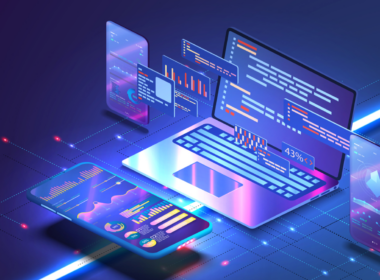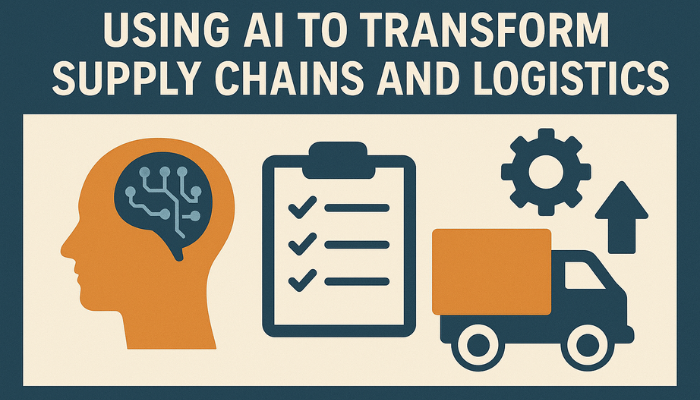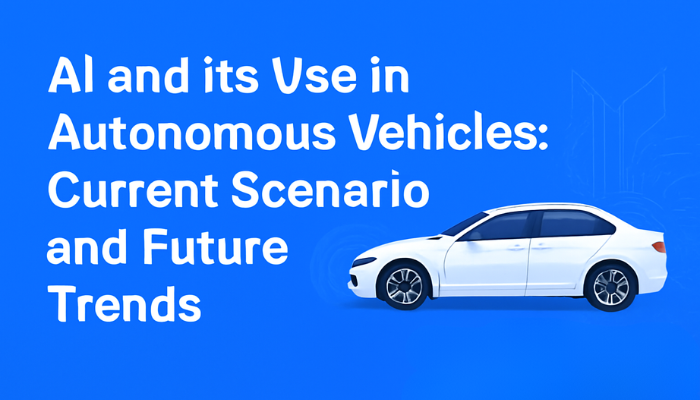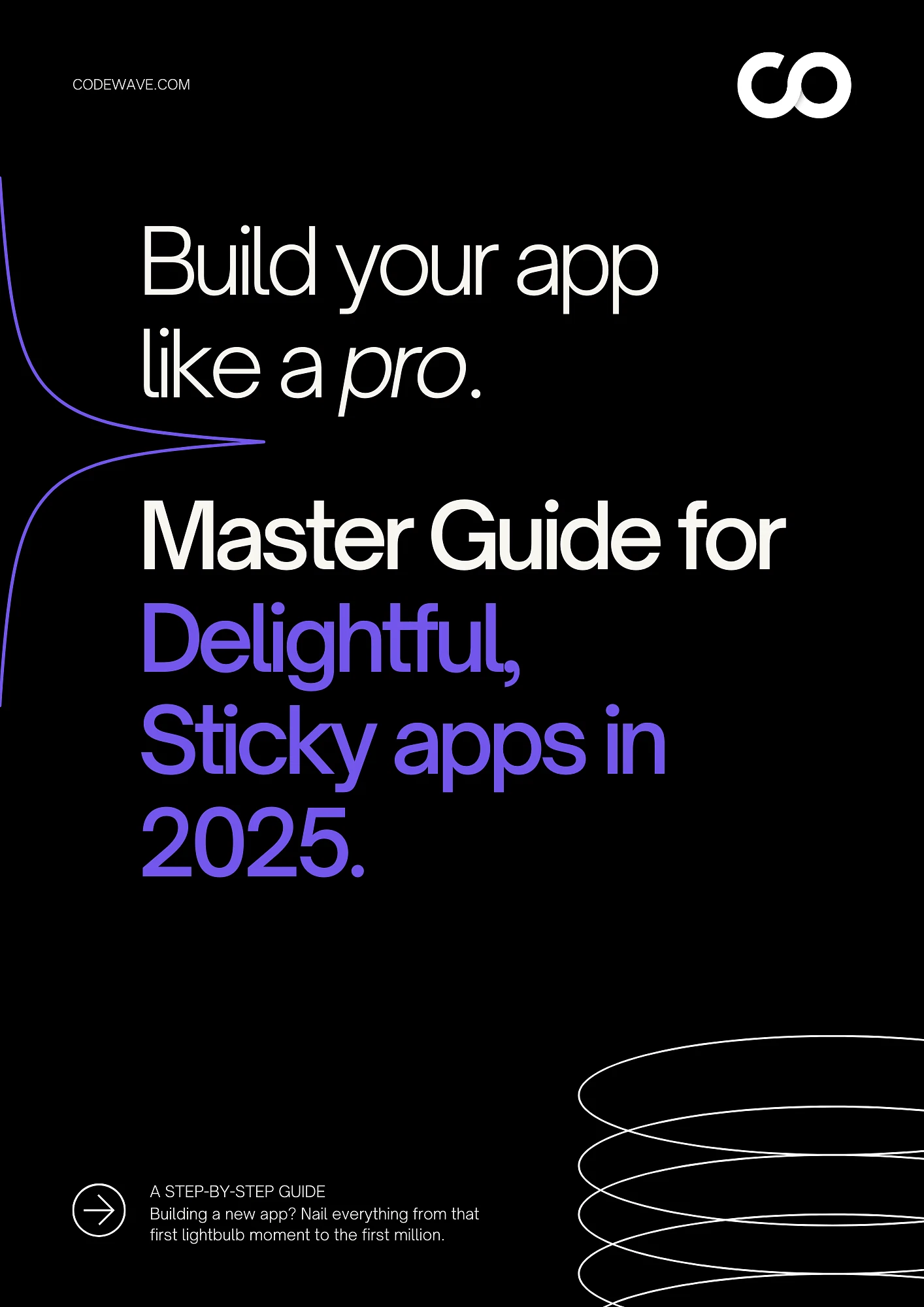Mobile applications are undergoing a dramatic evolution, powered by leaps in on-device and cloud-based AI. The broader AI market is projected to grow from USD 279 billion in 2024 to USD 1.81 trillion by 2030, at nearly 36 percent CAGR. This growth reflects a surge in demand for intelligent, responsive, and personalized mobile experiences.
If you are leading a mobile product team, you no longer need to ask whether to embed AI. The real challenge is deciding how and which AI capabilities to adopt first. This blog outlines the most impactful AI trends reshaping mobile apps, explores how they enhance UX, performance, and security, and guides you on a pragmatic roadmap to capitalize on them effectively.
What AI Actually Means for Mobile Applications
AI in mobile apps is more than a machine learning model embedded in the stack. It’s about apps that adapt intelligently, sensing user context, predicting needs, and delivering timely, personalized experiences without hardcoded rules.
At the user level, AI takes shape through:
- Voice assistants that understand context and complete multi-step tasks: For example, a travel app assistant can rebook a flight, check hotel availability, and notify contacts, all triggered by a single “My flight got canceled” command. This reduces user friction and drives higher in-app retention.
- Recommendation engines that continuously adapt to user intent: An ecommerce app may promote accessories that match items left in the cart or suggest alternatives based on recent returns. This boosts conversion rates and average order value.
- Chatbots that manage service workflows, not just queries: In fintech apps, AI chatbots can help users apply for a credit card, verify documents, and resolve disputes without manual support. This cuts service costs and improves satisfaction.
- Predictive inputs that anticipate actions before the user starts typing: A food delivery app might auto-populate the user’s usual order based on time, location, and dietary patterns, speeding up ordering and increasing repeat usage.
These are examples of AI-powered features, which are visible, interactive, and central to the user experience.
But there’s also a more subtle layer: AI-augmented backend systems. These don’t show up as standalone features but influence app behavior through real-time decisioning. For example:
- A personalization engine that changes homepage layout based on user segmentation: For example, a fitness app might highlight strength training plans for athletes and beginner guides for new users, improving engagement and reducing churn by aligning content with individual goals.
- Dynamic pricing updates based on demand signals and location: A ride-hailing app can adjust fares during peak hours or in high-demand zones to maximize driver availability and revenue per trip while maintaining service reliability.
- Fraud detection models influencing transaction approvals in a finance app: By analyzing behavior patterns in real time, an AI model can block suspicious payments before they complete, minimizing fraud loss and preserving customer trust without adding manual review delays.
This distinction matters. Many apps rely on static rules or analytics dashboards. AI-powered apps evolve automatically with new behavior patterns, delivering operational agility, reduced manual effort, and higher lifetime value per user.
Explore AI agents beyond chatbots
Read: A Comprehensive Guide to AI Agents and learn how autonomous AI components can power smarter mobile experiences.
Understanding this difference helps mobile teams set realistic goals, design the right data flows, and choose appropriate AI tools during development.
Key Trends Shaping AI in Mobile App Development
AI in mobile applications is evolving rapidly, not just in capability but also in how it is embedded into everyday experiences. The following five trends are driving how mobile teams integrate intelligence into product design and architecture.
1. On-Device Intelligence (Edge AI and Privacy-First Design)
With increasing privacy regulations and user expectations around data security, more developers are shifting toward on-device inference. Edge AI allows apps to perform tasks like facial recognition, gesture control, or language processing without sending data to the cloud. This improves response times and preserves user privacy, especially in healthcare, banking, and personal wellness apps.
Apple’s Core ML and Google’s Edge TPU are leading this push, allowing even complex models to run locally on devices with limited compute.
2. Generative UI
Generative AI is being used not just for content, but for real-time UI adaptation. Mobile apps now use AI to assemble dynamic interfaces that respond to user roles, habits, or preferences. For example, a sales app might rearrange dashboards for a field rep vs. a manager, or an ecommerce app might rewrite product descriptions based on past browsing.
This trend demands a shift from static screens to component-driven, AI-orchestrated layouts.
3. Intent-Based Navigation
Rather than waiting for users to tap through menus, apps now predict intent based on behavioral signals. AI models analyze past actions, time of day, device signals, and even sentiment to anticipate what the user wants to do next.
Whether it’s preloading the next podcast episode, surfacing frequently used tools, or offering shortcuts in real time, these systems make mobile experiences faster and more fluid.
4. Multimodal Interaction
Modern apps are increasingly built for multimodal input. AI now supports interactions that span visual recognition (camera input), voice commands, and haptic gestures.
A travel app might let users scan a landmark, ask for its history via voice, and then save it with a swipe. These interfaces break the mold of traditional screen-based design and create more immersive user journeys.
5. Real-Time Language Translation and NLP Pipelines
Natural language processing (NLP) has become fundamental to AI in mobile apps. From voice assistants to in-app chat support, NLP is powering faster, more natural communication. Real-time translation features are also unlocking global reach for apps in education, travel, and commerce.
With transformer-based models becoming more efficient, translation and summarization can now happen live, even with complex user-generated content.
Discover the tools enabling these trends
Read: Top AI Agent Frameworks for Effective Automation to explore ecosystems like TensorFlow Lite, Core ML, and new agentic frameworks for mobile.
How AI Is Redefining User Experience in Mobile Apps
AI is fundamentally changing how users interact with mobile apps. Instead of navigating rigid menus and fixed layouts, users now engage with adaptive interfaces that learn and evolve over time. The shift is not just about visual design. It’s about intelligent systems anticipating needs and shaping experiences in real time.
Adaptive UI/UX That Evolves With Behavior
Modern apps use AI to analyze user patterns: scroll speed, tap zones, preferred time of use and adapt the interface accordingly. An app might promote key actions during peak usage hours, simplify menus for novice users, or switch color themes based on ambient light or user settings.
In fitness apps, AI-driven dashboards surface the most relevant stats (like sleep or steps) depending on recent activity. For a trader using a finance app, high-volatility alerts might take UI priority during market hours.
Micro-Personalization at Screen Level
AI enables not just macro-level content changes but micro-adjustments down to the component level. Think: adjusting button sizes based on touch history, reordering card views based on interaction rates, or toggling features for left-handed users.
This level of fine-tuning transforms apps from static systems into living interfaces that match individual behavior profiles.
Conversational Interfaces Replacing Menus
Traditional menu trees are increasingly giving way to voice and chat-based inputs. AI-powered conversational UIs allow users to ask for features, query data, or take actions using natural language.
In a banking app, a user might type “How much did I spend on groceries last month?” instead of navigating to multiple screens. These interfaces make apps more intuitive and reduce friction, especially for first-time users or non-technical audiences.
Use Cases Across Industries
- Ecommerce: Personalized shopping assistants suggest products, apply discounts, or answer product questions on the fly.
- Health apps: Interfaces evolve based on fitness goals, medical conditions, or behavioral adherence, improving engagement and outcomes.
- Finance dashboards: AI curates relevant KPIs based on financial behavior, account changes, or risk levels, streamlining user decision-making.
In each case, AI moves the app beyond being a tool and into being a partner, actively shaping experiences based on who the user is and what they need at the moment.
AI in Mobile App Infrastructure: Beyond the Frontend
AI is no longer confined to the visible parts of mobile apps. It is increasingly embedded in the infrastructure, where it supports more resilient operations, faster delivery cycles, and smarter resource allocation.
Predictive Analytics in Crash Reporting and QA
Modern QA workflows now use AI to analyze crash logs and session data to identify patterns that signal potential failures. Instead of waiting for users to report bugs, predictive analytics helps you pinpoint unstable code paths or compatibility issues across devices and OS versions. This shortens resolution cycles and reduces time in triage.
Intelligent Automation in CI/CD and Deployment
AI enhances continuous integration and deployment by automating repetitive and error-prone tasks. It can generate targeted test cases based on code changes, flag high-risk commits, and optimize rollout timing by evaluating usage patterns. Your engineering team gains higher confidence in each release without increasing manual workload.
Dynamic Backend Scaling for User Clusters
AI models can detect usage surges among specific user segments and allocate compute resources accordingly. Whether it is scaling services for high-spend customers during flash sales or reducing backend load in underused geographies, this level of dynamic orchestration leads to better performance and lower infrastructure costs.
Data Sources Driving AI in Mobile Apps
AI-powered apps rely on the right kind of data to make smart decisions. Here’s what that means in practice:
- User Behavior Inside the App: Every tap, scroll, and swipe tells the system what users like, ignore, or find confusing. This helps personalize screens, suggest relevant content, and detect early signs of drop-off.
- Device Feedback and Usage Context: The app can adjust based on phone battery level, network speed, or motion sensors. For example, a video app might lower quality if your signal is weak, keeping playback smooth.
- Connected Devices (IoT Signals): Apps now talk to wearables and smart gadgets. A fitness app might tailor alerts based on your smartwatch data. A car app can remind you of engine issues using real-time sensor input.
- Responsible Data Use and Privacy: Apps must follow rules like GDPR and CCPA. That means getting consent before collecting data, keeping personal info secure, and using it only for what users agreed to.
These data sources allow AI to make mobile apps smarter, safer, and more personal without crossing privacy lines.
Got real-time mobile data? Let’s make it actionable.
Talk to our data engineering team about integrating device, IoT, and telemetry pipelines.
Design and Development Implications of AI in Mobile Apps
AI is not just a layer added on top of mobile apps. It reshapes how apps are designed, architected, and maintained. From development frameworks to deployment pipelines, building intelligent mobile systems means rethinking the app lifecycle.
AI-Ready Frameworks
Mobile development now integrates lightweight, on-device AI models using tools like:
- Core ML (iOS): Optimized for Apple devices, it supports custom and pre-trained models while preserving privacy by running models locally.
- TensorFlow Lite: Google’s solution for running ML models on mobile and embedded devices with reduced latency.
- MediaPipe: Ideal for real-time perception, MediaPipe enables features like face detection, pose estimation, and object tracking.
- ML Kit: Firebase’s AI SDK allows Android and iOS apps to embed features like text recognition, translation, and barcode scanning without deep ML knowledge.
These tools help teams embed intelligence directly into the app without cloud dependency, improving both privacy and responsiveness.
Architecture Shifts: Micro-Agent Thinking
Traditional MVC (Model-View-Controller) structures are giving way to more reactive, context-aware architectures. Intelligent agents, modular components with specific reasoning and action capabilities, monitor app state and user signals in real time, triggering dynamic UI adjustments or backend calls. This event-driven model enables apps to feel adaptive rather than static, reducing user friction and increasing engagement.
Human-in-the-Loop vs Autonomous Decisions
In AI-enabled mobile apps, the question arises: when should the system act autonomously, and when should it defer to the user? For instance, a fitness app might automatically classify workouts based on motion patterns, but prompt users to confirm before logging. Clear design boundaries are essential to avoid user mistrust while maximizing convenience.
Design teams need to strike a balance, building autonomy into low-risk features and maintaining explainability or manual control in higher-stakes actions.
Testing and Release Considerations
AI features introduce variability and non-deterministic behavior, which makes testing more complex. Instead of static test cases, teams need simulation-based validation, continuous performance monitoring, and A/B testing with behavioral analytics. This shifts QA processes from binary pass/fail to confidence-level validation.
App updates also evolve. Rather than full app store releases, teams may deploy new models or update agent policies server-side. This decoupling of AI behavior from app binaries shortens release cycles and supports rapid iteration, but also demands tighter model governance and rollback strategies.
Gaining Business Value from AI in Mobile Applications
AI is driving tangible business outcomes in mobile apps by powering systems that adapt to user behavior in real time. These systems go beyond UI enhancements to deliver strategic gains in retention, monetization, and user lifecycle management.
Personalization-Driven Retention and LTV Optimization
Using embedded models on-device or server-side, mobile apps can analyze session data, feature engagement, and behavioral history to create personalized flows. This includes customizing onboarding paths, adjusting interface complexity, or prioritizing frequently used features. These interactions are calibrated to retain users longer and increase lifetime value through relevance, not guesswork.
Micro-Intent Detection for Smarter Upselling
AI tracks subtle behavioral cues such as dwell time on premium features or frequency of usage spikes. Based on these micro-intents, the app can trigger dynamic pricing models or targeted upgrade prompts. For example, a productivity app might offer an AI-suggested workflow automation trial after repeated manual task repetitions.
Proactive Churn Reduction Through Usage Modeling
Apps can use sequence modeling techniques to identify signs of disengagement, like decreasing session intervals or incomplete workflows. Trained models then trigger in-app nudges or contextual interventions, such as personalized offers or gamified challenges, to re-engage the user before abandonment occurs.
Case Insight: Financial App Leveraging AI-Based Usage Scoring
A mobile banking platform used AI to score user engagement based on transactional activity, savings behavior, and support interactions. When a user’s score fell below a threshold, the system automatically surfaced contextual recommendations such as setting savings goals or enabling spending alerts. This real-time responsiveness helped reduce inactive accounts and increased feature adoption across segments.
Want to build ROI into your design?
Learn how to simulate ARPU uplift and churn reduction.
[Schedule a Value-Modeling Session]Challenges of Implementing AI in Mobile Applications
While AI brings powerful enhancements to mobile app experiences, it also introduces operational and ethical risks that teams must proactively address. The shift toward on-device intelligence adds complexity across performance, compliance, and trust dimensions.
Model Drift in On-Device AI
As user behavior and app features evolve, preloaded models can become outdated. This leads to model drift, where predictions no longer align with current usage patterns. Without server-side updates or federated learning frameworks, these discrepancies can degrade user experience over time. Teams need a strategy for model versioning, periodic refreshes, and compatibility management with OS-level APIs.
Ethical and Personalization Bias
AI-driven personalization can reinforce feedback loops that exclude edge users or minority behaviors. For instance, if a fitness app consistently promotes goals based on majority demographics, it may ignore underrepresented user needs. Mitigating bias requires diverse training data, fairness audits, and configurable personalization settings that allow users to recalibrate their app experience.
Performance Trade-Offs and Battery Optimization
Running inference locally on devices increases CPU or GPU load, which can drain battery or interfere with foreground UI tasks. Developers must implement lightweight models using quantization, pruning, or distilled architectures. Leveraging accelerators like Apple’s Neural Engine or Android NNAPI helps, but intelligent scheduling and load management remain essential to maintain responsiveness.
Security and Privacy in On-Device AI
On-device inference reduces cloud exposure but introduces its own risks. Models and inference outputs stored on-device must be encrypted to prevent tampering or reverse engineering. Apps must also ensure compliance with privacy regulations like GDPR or CCPA, especially when combining local telemetry with cloud-based aggregation for optimization or analytics.
The Future of Mobile Apps: AI-Native Architectures
The mobile ecosystem is entering a new phase where AI is not just a feature but the foundation of application logic. This distinction is critical. While many apps today are AI-enabled, using models for recommendations or voice recognition, AI-native apps are architected from the ground up with autonomy, context, and real-time decisioning at their core.
From AI-Enabled to AI-Native
AI-enabled apps typically bolt AI capabilities onto traditional workflows. A fitness app might use a model to suggest workouts based on history, but the flow remains static. In contrast, an AI-native app can reconfigure its interface, suggest routines based on sensor fusion, and even adapt challenge levels based on inferred motivation or fatigue without waiting for user input.
This shift requires changes in architecture, data lifecycle, and human-AI interaction patterns. AI-native apps continuously reason, act, and evolve. They do not simply assist; they decide, respond, and adapt in the moment.
Agentic AI in Mobile Contexts
Agentic AI introduces persistent, autonomous entities within the mobile runtime. Think beyond chatbots. These are context-aware agents embedded into the app logic that monitor state, trigger actions, and optimize flows without central orchestration.
For example, in a healthcare app, an agent might manage medication reminders not just by time, but by combining biometric signals, calendar conflicts, and past adherence patterns. In a gig-work app, an agent could dynamically schedule jobs, negotiate time slots, and reroute logistics in real time based on user preferences and external disruptions.
This autonomy allows mobile apps to operate as intelligent assistants that adapt not just to the user but also to the operational ecosystem they interact with.
Next-Generation Opportunities
AI-native mobile apps open the door to hypercontextual and persistent experiences:
- AI Companions: Lightweight agents that learn across sessions, understand context beyond a single screen, and provide longitudinal insights. Think mental health support or career coaching apps with memory and emotional intelligence.
- Multimodal Fusion: Combining visual, audio, location, and behavioral data to create interfaces that understand the user’s intent in a holistic manner.
- Adaptive Monetization: Apps that adjust pricing models, upsell logic, or service tiers based on real-time usage, churn risk, and lifecycle stage without predefining static tiers.
AI-native design isn’t just a technical shift. It redefines how mobile products are built, experienced, and monetized.
Why Codewave for AI‑Driven Mobile Applications
Choosing the right partner for your AI‑driven mobile app can make all the difference between launching another feature‑laden app and delivering a truly intelligent user experience. At Codewave, we combine deep AI expertise, mobile engineering excellence, and UX-first design, ensuring your app not only works, but delights and scales.
AI and Mobile Engineering Expertise
Our data scientists and mobile engineers collaborate to implement robust on‑device intelligence using frameworks like Core ML, TensorFlow Lite, and ML Kit. We optimize models for performance and battery efficiency while deploying backend inference pipelines that enhance predictive analytics and crash reporting. This holistic approach enables apps that are responsive, secure, and proactive. Explore our AI App Development services!
UX‑Centric Approach
AI features must integrate seamlessly into the user experience, not be added as afterthoughts. Our UX team designs contextually adaptive interfaces and conversational flows that feel natural and intuitive. Whether AI is powering recommendation screens or intent-based navigation, our designs prioritize clarity and delight, reducing cognitive load and increasing engagement.
Scalable Architecture
We engineer your app on a future-ready foundation, shifting from MVC or MVVM patterns to event-driven micro‑agent architectures. This ensures modularity, simplifies updates, and enables autonomous UI features and in‑app agents without massive rewrites. We also embed secure CI/CD pipelines and monitoring to support continuous updates and safe deployments.
Proven Track Record
We’ve delivered AI‑power applications across industries including ecommerce, finance, and healthtech. From apps that reduce fraud through real‑time scoring to customer‑centric platforms that dynamically personalize UX, our portfolio reflects measurable improvements in retention, lifetime value, and conversion rates.
Whether you are leading a startup or managing enterprise platforms, the strategic use of AI will determine your app’s relevance and performance in the years ahead. Codewave can help you design, prototype, and deploy AI-powered mobile solutions that deliver measurable business value. Ready to explore what AI can do for your app?
Schedule a 30-Minute Strategy Session with our mobile AI experts.
Codewave is a UX first design thinking & digital transformation services company, designing & engineering innovative mobile apps, cloud, & edge solutions.







